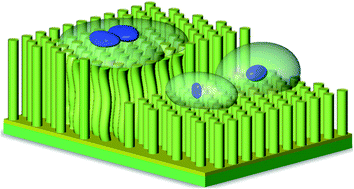Fabrication of biocompatible high aspect ratio Au–Ni coaxial nanorod arrays using the electroless galvanic displacement reaction method†
Abstract
In this study, a novel method of fabrication of high aspect ratio magnetic Au–Ni coaxial nanorod arrays is proposed. The fabrication procedure involves anodic aluminum oxide (AAO) template preparation, barrier-layer surface photolithography, barrier layer etching, working electrode coating, nickel electroforming, alumina etching, and gold-plating by the electroless galvanic displacement reaction (EGDR) process. Experimental results have demonstrated that it is possible to synthesize high aspect ratio magnetic Au–Ni coaxial nanorod arrays using the method proposed in this study. The aspect ratio of the synthesized Au–Ni coaxial nanorod arrays was estimated to be 100–140. A two-dimensional electromagnetic force actuating system was set up to manipulate the 2-D movement of a patterned Au–Ni coaxial nanorod array. Biocompatibility of the proposed Au–Ni coaxial nanorod array was confirmed through the culture of endothelial cells (ECs) on the array surface. The influences of the stiffness of the nanorod array in terms of its height on cell morphology and differentiation were investigated. The results of the cell culture indicate that our Au–Ni coaxial nanorod array can be used to manipulate the differentiation of cells cultured on it by adjusting the array height.


 Please wait while we load your content...
Please wait while we load your content...